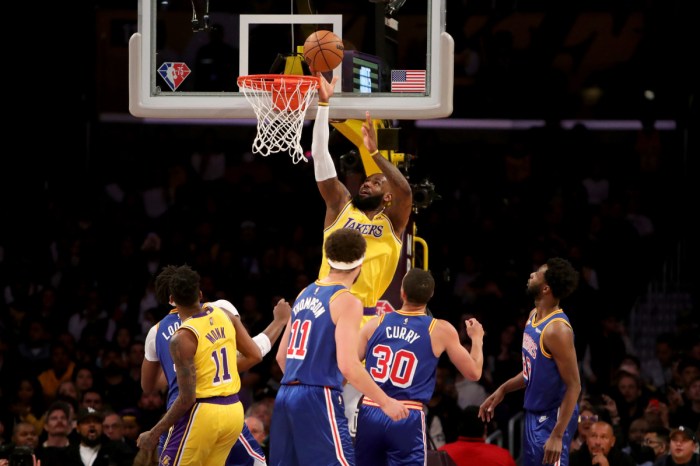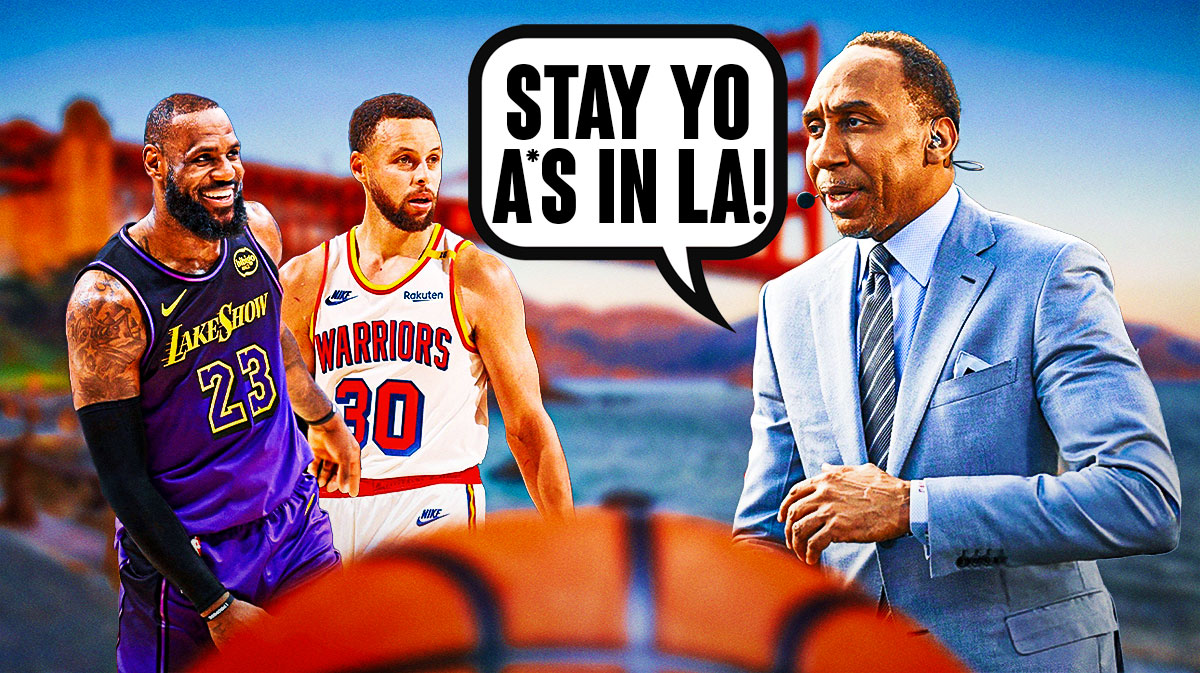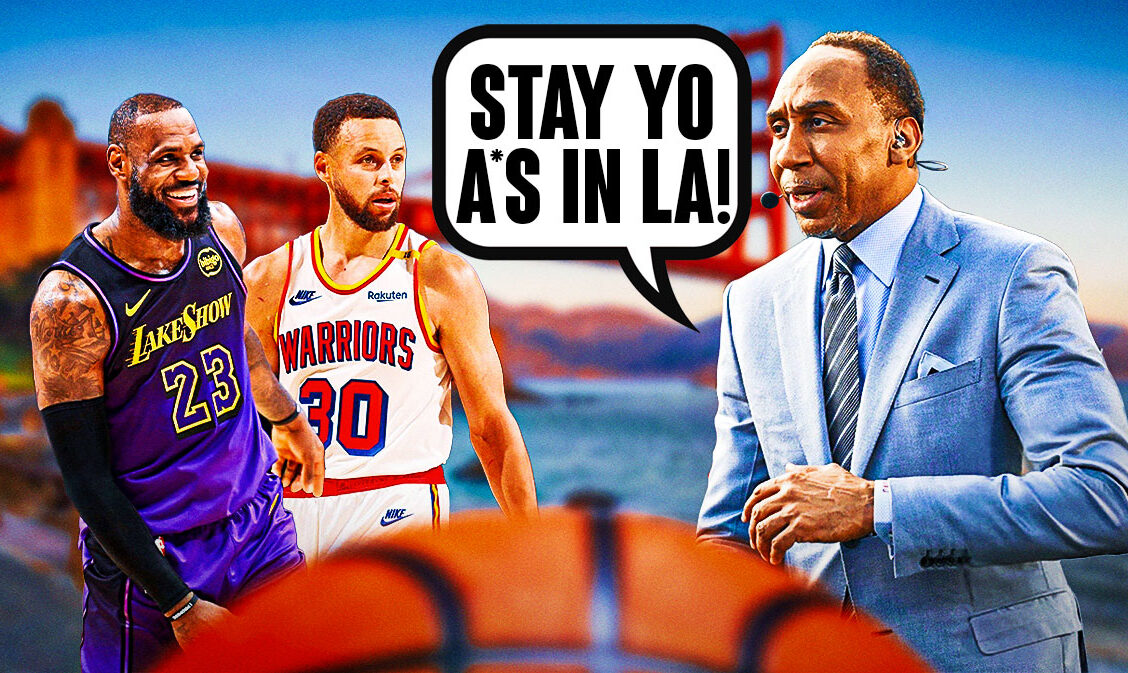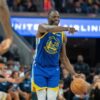What it would have taken to get LeBron James to the Warriors at the trade deadline is a fascinating hypothetical. Imagine the Warriors assembling a package of assets, considering LeBron’s potential motivations, and navigating the complex NBA trade market. Could a blockbuster deal have actually happened, or were there insurmountable obstacles?
This deep dive explores the potential trade packages, LeBron’s possible interest, external factors, negotiation strategies, and the impact on both teams. We’ll examine historical precedents and ultimately attempt to answer the question: What would have been enough to bring the King to the Bay Area?
Potential Trade Packages

The possibility of LeBron James joining the Golden State Warriors at the trade deadline was a captivating notion, sparking intense speculation about potential trade packages. While the move ultimately did not materialize, understanding the potential deals that could have been offered provides valuable insight into the intricacies of professional basketball trades and the perceived value of different players.The Warriors, with their existing roster and championship aspirations, would have had to carefully consider the assets they could offer in exchange for a player of LeBron James’s caliber.
Different combinations of players and draft picks would have been evaluated based on the market value, team needs, and the overall balance of the roster.
Potential Player Combinations
The Warriors, with a relatively young core, likely would have explored trades involving combinations of established role players and draft picks. A significant portion of any potential trade package would have likely revolved around draft capital, as it represents future potential and allows the team to build a winning roster. This approach aligns with the Warriors’ known approach to building a strong foundation for future success.
Potential Assets the Warriors Could Have Offered
- Jordan Poole: A young, dynamic shooting guard, Poole presents a high-potential trade asset. His scoring ability and shooting prowess would likely hold significant value in the market, although the Warriors might have been hesitant to part with a player who has shown signs of developing into a key piece of the future.
- James Wiseman: Wiseman, a talented center with high potential, might have been included in a package to add depth and athleticism to the trade, depending on the perceived value of his development. Teams seeking to build around a younger core might see him as a potential asset, considering the long-term potential he offers.
- Draft Picks: Draft capital, especially future picks, is almost always a key component of any significant trade. The Warriors, holding draft capital, could have used future first-round picks or multiple second-round picks to sweeten the deal and potentially acquire additional assets.
Trade Package Comparisons
Evaluating the different trade packages from various perspectives is crucial. A trade involving Poole, Wiseman, and draft picks could have addressed the Warriors’ need for immediate impact players, while maintaining future potential. However, such a deal would require a careful consideration of the long-term impact on the team’s core. The value of players like Poole and Wiseman needs to be carefully weighed against the need for experienced players.
Other potential assets, such as veterans or lesser-known players, would need to be assessed based on their current performance and market value.
Trade Package Table
| Player | Position | Value | Impact on Team |
|---|---|---|---|
| Jordan Poole | Shooting Guard | High | Potential scoring and shooting threat |
| James Wiseman | Center | Medium-High | Adds athleticism and potential long-term value |
| 2024 First Round Pick | Draft Pick | High | Significant future asset for roster building |
| 2025 Second Round Pick | Draft Pick | Medium | Adds future roster depth |
LeBron’s Potential Interest
LeBron James’s legendary career has always been marked by strategic moves and calculated decisions. His motivations often extend beyond simple on-court performance, encompassing factors like team fit, legacy, and personal aspirations. Understanding the potential factors influencing his interest in joining the Golden State Warriors at the trade deadline requires examining the circumstances surrounding the potential move.Analyzing LeBron’s potential interest necessitates a comprehensive understanding of the Warriors’ environment, his personal aspirations, and the potential benefits and drawbacks of such a move.
His decision-making process would likely involve weighing various factors to determine if joining the Warriors at that specific time aligned with his broader goals and personal preferences.
Possible Motivations for Joining the Warriors
LeBron’s potential motivations for joining the Warriors at the trade deadline could have stemmed from several factors. A desire to compete for a championship in a highly-competitive environment, perhaps seeking a new challenge and a chance to add another ring to his impressive collection, could have been a significant motivator. He might have been drawn to the Warriors’ established championship culture and the opportunity to learn from and collaborate with other high-caliber players.
The possibility of joining a team with a proven track record of success could have also been a strong incentive.
Factors Influencing LeBron’s Decision
Several factors could have influenced LeBron’s decision to join the Warriors, had he been interested. The team’s current roster composition, with a mix of experienced veterans and promising young talent, might have presented an appealing prospect. The presence of key players with whom he could potentially build strong relationships and form effective on-court partnerships could have been a deciding factor.
Furthermore, the Warriors’ strong offensive system, which often emphasized player versatility and offensive creativity, could have attracted him to the prospect of maximizing his own offensive contributions.
Getting LeBron James to the Warriors at the trade deadline would’ve required a massive package, likely including multiple high-value assets. The kind of move that would make a ripple effect, especially considering the recent breaking news in Jordan now, and the Warriors’ current roster construction. It just wouldn’t have fit the pieces together in a way that made sense, even if the desire was there.
Ultimately, a deal of that magnitude probably wouldn’t have been feasible given the circumstances.
Factors Deterring LeBron from Joining
Conversely, several factors might have deterred LeBron from joining the Warriors at the trade deadline. The Warriors’ injury situation, including the status of key players, could have raised concerns about the team’s ability to maintain peak performance. Concerns about the team’s overall chemistry and how well he might fit into the existing dynamic might have also been a significant factor.
The potential for a less-than-ideal role within the team structure, potentially altering his desired playing style or reducing his impact, might have been a major deterrent. Finally, the potential disruption to his existing personal and professional commitments could have been a significant consideration.
Warriors’ Team Culture and Environment
The Warriors’ team culture and environment at the time were characterized by a combination of experienced leadership, a strong emphasis on team unity, and a collaborative atmosphere. The players, having collectively achieved significant success, had a history of working together effectively, creating a winning environment.
“A strong team culture, built on trust and mutual respect, can significantly impact player motivation and performance.”
The Warriors were known for their innovative offensive system and high-level of athleticism, potentially appealing to LeBron’s desire to showcase his skills in a dynamic environment. However, the team’s existing chemistry and the specific roles available might have presented challenges to his personal playing style or goals. A detailed evaluation of these factors could have significantly influenced his decision.
Negotiation Strategies
The potential trade of LeBron James to the Warriors at the trade deadline would have been a complex negotiation, requiring meticulous strategy from both sides. Factors such as the player’s desires, the teams’ financial situations, and the overall competitive landscape would have significantly impacted the outcome. A successful negotiation would have required understanding and anticipating the motivations and needs of all parties involved.The Warriors, facing the formidable task of acquiring a generational talent, would have had to meticulously plan their approach to ensure a mutually beneficial trade.
Getting LeBron James to the Warriors at the trade deadline would’ve required a massive package, likely including multiple high-value assets. The kind of move that would make a ripple effect, especially considering the recent breaking news in Jordan now, and the Warriors’ current roster construction. It just wouldn’t have fit the pieces together in a way that made sense, even if the desire was there.
Ultimately, a deal of that magnitude probably wouldn’t have been feasible given the circumstances.
This would necessitate a deep understanding of LeBron’s potential interest, the market value of players involved in any potential trade package, and the willingness of the Lakers to part ways with their star player.
Potential Warriors Negotiation Strategies
The Warriors would have needed to present a compelling package that addressed the Lakers’ potential demands. This likely involved a combination of young, promising talent, draft picks, and potentially some financial considerations. The key would have been to offer a package that both satisfied the Lakers’ perceived value and allowed the Warriors to maintain their existing roster’s balance and future potential.
Understanding the Lakers’ needs and the market value of potential assets was paramount.
Challenges in Negotiating with LeBron’s Team
Negotiating with the Lakers would have presented numerous obstacles. The Lakers, as the team holding the player’s rights, would have held significant leverage. Their primary concerns would have been the value of the players traded and the team’s overall financial implications. Potential complications included the player’s personal preferences, the complexity of contracts, and the potential for unforeseen factors.
These factors would have complicated negotiations.
LeBron’s Team’s Potential Negotiation Strategies
The Lakers, in seeking the best possible return for LeBron, would have likely prioritized maximizing the value of the trade. This could have involved demanding a substantial package of high-value assets and potentially including financial incentives. Understanding the Warriors’ existing roster and their potential to gain further success was critical for the Lakers’ negotiation strategy. The Lakers would have also considered the player’s personal preferences and aspirations in the process.
Comparison of Negotiation Styles
Different negotiation styles could have yielded varying outcomes. A collaborative style, emphasizing mutual benefit, might have led to a more amicable agreement, potentially resulting in a better package for the Warriors. However, a more competitive style, focused on maximizing individual gains, could have led to a more protracted negotiation process, potentially resulting in a less desirable outcome. Understanding each team’s motivations and objectives was crucial for successful negotiations.
Impact of Strategies on Trade Success
The effectiveness of the chosen strategies would have significantly influenced the likelihood of a successful trade. A well-prepared and comprehensive strategy, considering all potential variables, would have increased the chances of a positive outcome. Conversely, a poorly planned or inflexible approach would have likely hindered the trade’s completion. Foreseeing and preparing for potential roadblocks would have been vital.
Potential Impact on Both Teams
The possibility of LeBron James joining the Golden State Warriors at the trade deadline ignited a whirlwind of speculation and analysis. Such a move would have been unprecedented, potentially reshaping the landscape of the NBA, and the implications for both teams would have been profound. The impact on the Warriors’ already formidable roster, the alteration of their game plan, and the ripple effect on the league would have been significant.
Conversely, the departure of LeBron from his current team would have left a considerable void.The Warriors, with their existing core of Stephen Curry, Klay Thompson, and Draymond Green, were already a formidable force. The addition of LeBron James would have further solidified their position as a championship contender.
Potential Impact on the Warriors’ Roster
The addition of LeBron James to the Warriors would have significantly altered the team’s dynamic. His presence would have demanded a reevaluation of their offensive and defensive strategies. The Warriors would have had to adapt to incorporate LeBron’s unique skillset into their existing system. He brings an unparalleled ability to dominate the paint, create scoring opportunities for teammates, and impact the game defensively.
Changes in Team Dynamics and Strategy, What it would have taken to get lebron james to the warriors at the trade deadline
The introduction of LeBron would have altered the Warriors’ team dynamics. The established offensive flow and roles would have had to adjust to LeBron’s presence. The Warriors’ strategy would have had to incorporate his offensive and defensive strengths. They might have transitioned from a primarily perimeter-oriented attack to a more balanced approach, potentially incorporating more pick-and-roll plays and utilizing LeBron’s ability to create space for others.
Impact on LeBron James’ Career Trajectory
Joining the Warriors would have presented LeBron James with the opportunity to compete for more championships. The Warriors’ established success and the presence of proven stars could have potentially led to increased pressure and scrutiny. His career trajectory would have likely depended on his individual performance and the team’s ability to adapt to his presence.
Impact on the Team LeBron James Left Behind
The departure of LeBron James would have left a massive void for the team he would have left. His leadership, experience, and impact on the game would be irreplaceable. The team would have faced a period of adjustment, potentially requiring significant changes to their strategy, personnel, and leadership structure. This could have impacted their future prospects, both short-term and long-term.
Comprehensive Analysis of Future Prospects
The potential trade would have dramatically altered both teams’ future prospects. The Warriors would have likely seen an immediate boost in their championship aspirations, but the long-term effects on the team’s identity and chemistry would have been uncertain. For the team LeBron would have left, the void would have been profound, potentially affecting their short-term and long-term success.
Figuring out what it would have taken to land LeBron James with the Warriors at the trade deadline was a complex puzzle. Predicting the reported 4 extra matches WWE adds to WrestleMania 40 card here is a similar exercise in assessing likely outcomes, although in a very different arena. Ultimately, a combination of factors, including player preferences and team needs, would have been crucial in getting LeBron to the Bay Area.
Factors like the team’s existing talent and the availability of suitable replacements would have influenced the long-term implications.
Historical Precedents: What It Would Have Taken To Get Lebron James To The Warriors At The Trade Deadline

The possibility of LeBron James joining the Golden State Warriors at the trade deadline raises intriguing questions about the feasibility of such a move. Examining past instances of star players joining teams mid-season provides valuable context. Analyzing successful and unsuccessful trades, and understanding the factors that influenced them, offers a framework for understanding the potential hurdles and opportunities in a hypothetical LeBron James-Warriors deal.Historical examples of star players joining teams at the trade deadline are not as common as those occurring during the offseason.
This is largely due to the logistical and financial complexities involved, especially in the case of a player of LeBron’s stature. However, some instances provide illuminating comparisons and offer insight into the potential obstacles and motivations that could have influenced a move.
Examples of Mid-Season Star Player Trades
Mid-season trades of high-profile players are not frequent, and their success often hinges on various factors beyond just talent. Teams need to assess their current roster composition, the player’s specific motivations, and the potential impact on the league’s balance of power.
- The 2019 trade of Anthony Davis from New Orleans to Los Angeles Lakers provides a case study. The trade was primarily motivated by the Lakers’ desire to build a championship-caliber team, and the player’s willingness to join a contender. A key factor was the player’s aspiration to win, which influenced his decision to accept the trade, as it aligned with the team’s ambitions.
A crucial factor in the success of this trade was the synergy created by the addition of a player of Davis’ caliber to a team already containing significant talent.
- Conversely, consider the 2017 trade of Paul George from Oklahoma City to Los Angeles Clippers. While this move ultimately proved successful for the Clippers, it also exemplifies the complexity of such transactions. The trade had both immediate and long-term implications. The Clippers were aiming for immediate improvement and a stronger playoff position, while the player’s ambition to play for a team that could compete for championships directly motivated his decision.
Motivations and Circumstances Surrounding Trades
Understanding the specific motivations behind these trades is critical to assessing the likelihood of a similar move involving LeBron James. Players’ desires for a change of scenery, team dynamics, and the potential for a championship run are all key considerations. Analyzing these aspects reveals the complex interplay of factors driving such decisions.
- Player aspirations and personal ambitions are often at the forefront of mid-season trades. LeBron’s own desire for a championship, coupled with the potential to lead the Warriors to victory, could be a significant motivator in such a hypothetical scenario. A player’s assessment of their potential impact on the team’s success and the team’s immediate prospects are also significant motivators.
- The financial implications of a trade, especially for a player of LeBron’s caliber, are significant. The player’s contractual obligations and the team’s financial resources directly influence the feasibility of a mid-season trade. Financial incentives and contractual considerations play a critical role in the negotiation process.
Comparison to the LeBron James Scenario
Applying these precedents to the potential LeBron James trade reveals crucial distinctions. LeBron’s legacy, experience, and status as a generational player elevate the complexity and significance of any potential trade. Assessing the factors that contributed to past trades in comparison with the specific situation of LeBron James offers valuable insight.
- The existing roster and team dynamics in the Warriors would be a critical factor. The Warriors’ current roster, including their core players and the existing chemistry, will be key in determining the impact of a LeBron James addition.
- The potential impact on the balance of power in the NBA is also important. The addition of LeBron James to any team would significantly alter the league’s landscape. The overall effect on the league’s competitive balance is a crucial aspect to evaluate.
Conclusion
Ultimately, the possibility of LeBron James joining the Warriors at the trade deadline remains a compelling discussion point. While specific details and motivations remain speculative, this exploration provides a nuanced understanding of the factors that could have influenced a potential deal. The analysis highlights the intricate web of circumstances surrounding such a move, and ultimately, the dream of seeing LeBron in Golden State remains just that—a dream.



